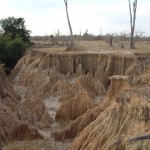 Kabwe, almost exactly half way between Lusaka and Ndola, is not a town where one would plan a weekend away (unless it’s at Mulungushi Dam). For most of us, it’s a ‘dirty little town’ on the road between Lusaka and the Copperbelt, a town where we know that Zacaria Phiri is going to be out in force checking vehicles, a town where we are going to get stuck behind a slow moving truck and a town where there are speedhumps to slow down your approach to and departure from the railway line. The fact that the trains don’t seem to run very often, so much so that mishanga sellers have set up their stalls across the railway lines, obviously didn’t figure when the road engineers planned the speed humps. But the fact remains, most of us keep to the ‘main’ road,Independence Avenue, never turning down a side road to see what might be found around the town.
Kabwe, almost exactly half way between Lusaka and Ndola, is not a town where one would plan a weekend away (unless it’s at Mulungushi Dam). For most of us, it’s a ‘dirty little town’ on the road between Lusaka and the Copperbelt, a town where we know that Zacaria Phiri is going to be out in force checking vehicles, a town where we are going to get stuck behind a slow moving truck and a town where there are speedhumps to slow down your approach to and departure from the railway line. The fact that the trains don’t seem to run very often, so much so that mishanga sellers have set up their stalls across the railway lines, obviously didn’t figure when the road engineers planned the speed humps. But the fact remains, most of us keep to the ‘main’ road,Independence Avenue, never turning down a side road to see what might be found around the town.
I say the ‘main road’. Ask any resident of Kabwe and they will tell you that Independence Avenue is not the main street of Kabwe. Rather, the main street is Freedom Way, the road running parallel to Independence Avenue to the south. It is in this street that you will find one of Zambia’s declared monuments and national heritage sites – the Big Tree.
The Big Tree is a fig tree, and I am reliably informed (by Mike Bingham) that it is a Ficus wakefieldii. This species of fig tree is usually found much further north and it is thought that this tree originated from a planted specimen although there are many mature trees of the same species in and around Kabwe. But this tree is special – its canopy stretches about fifty metres from side to side – a truly gigantic specimen – which must be a hundred years old or close to that. Photos taken in the 1950’s show an already enormous tree. The tree, in days gone by and still today, is a popular meeting or gathering place for the town’s people.
But all is not well with the Big Tree. On closer inspection, one can see some of the leaves have turned brown and a look underneath the green leaves and on some of the stems shows a white mealy substance. The experts tell us that this is woolly aphis or what is also known as mealy bug.
The question, of course, is what to do about it. First choice is obviously an organic pest management regime and there are many recommended – scrubbing the aphid colonies with a stiff-bristled brush, using an earbud dampened with alcohol to remove the bug, a mixture of mild detergent and water and wipe the bugs off with a soft cloth, spray Tabasco sauce or garlic extract on the aphids. Clearly none of these are achievable in this case.
Malathion is the recommended pesticide to use for woolly aphis and with its relatively low human toxicity, this may be a solution. But how to apply it? Ideally it should be sprayed where the damage is noticeable but with a tree this size, how does one do that? For house plants they also recommend spraying the organic material below the plants which may harbour the bugs. Will spraying the soil beneath the tree have any effect?
Will some pruning of the worst infested areas help? Certainly getting more air circulating around the leaves will help the general health of the tree. Or do we just leave it and hope that, as Mike Bingham says, it may shake it off on its own?
What do our other tree experts think? Are any of them prepared to take on this, if you will pardon the pun, monumental task?

Leave a Reply
You must be logged in to post a comment.